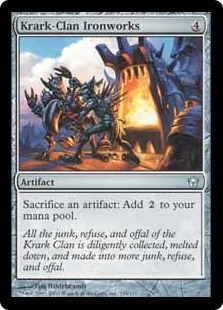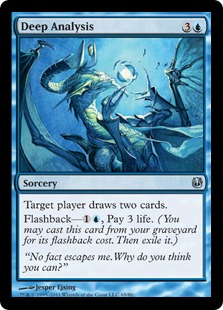EDH games are all about doing awesome stuff. I know this seems like a generic statement, but I'll explain. Most constructed formats are about winning as efficiently as possible (ex: Red Deck Wins in Standard), while keeping your opponents from killing you (ex: Merfolk in Legacy). EDH doesn't have the consistency to play control nor a low enough life total to support aggro, so to some extent; everybody in EDH plays a Combo deck. Most players are eliminated when one or more players possess a ridiculous board state and swing for lethal damage (or 21 general damage) in one turn or destroys all opponents' permanents (which happens to be Krark-Clan Ironworks, Spine of Ish Sah, Myr Turbine, and Dross Scorpion for me). This ridiculousness doesn't happen until about turn 20 or so (which can feel like 400 turns in a large multiplayer match). Regardless, all players have a good, long time to set up their field and bring out the best of their decks.
All interactions in the universe have a limiting factor that determines their speed and success. Magic happens to have two such limiting factors; cards in hand and available mana. David explained earlier how card advantage is important in EDH as a deck can quickly run out of steam if the player runs out of cards. Assuming you play one land and one spell each turn, a player will run out of cards in hand by turn seven and the game will slow down for that player. Obviously this doesn't happen every time, but unless you have a way to refill your hand, you'll likely run out of interactions with most of your opponents' plays. Most players Foresee this issue and play cards like Concentrate, Greater Good, Sign in Blood, and other card draw spells to keep gas in the tank. Similarly, spells in Magic (with few exceptions) cannot be played without mana. This is why an opening hand in EDH often has four lands, some ramp to ensure a strong mana base to player larger spells. Cards like Land Tax, Cultivate, and Armillary Sphere give the player a few extra lands for later turns. Solemn Simulacrum gets a special nod for doing both. =p
An article on TCGplayer.com by Craig Wescoe, Top 8 contender at Worlds 2011, discusses Three Models of Evaluating a Magic Game State. I'm going to try to summarize them quickly to illustrate my point. The card advantage model explains that the player with more cards has more options and has a better chance of winning the game. Deep Analysis allows the player to draw two cards for the price of one card (draw 4 after Flashback), which is an example of positive card advantage. Mind Rot, on the other hand, drains your opponent of two cards for the price of one, providing your opponent with negative card advantage (similar to tug-of-war, this equates to positive card advantage for you). Card advantage also occurs on the battlefield. Arc Trail can kill up to two creatures with one card; Acidic Slime destroys an artifact, enchantment, or land and usually takes a creature down when it dies using it's Deathtouch ability. The tempo model suggests that a more developed board in fewer turns presents a greater threat. Ramp spells like Sol Ring and Rampant Growth allow you to play big threats earlier by putting you ahead in the race of available mana. Aggressive creatures like Hero of Bladehold provide a player with seven power across three creatures that will win the game if left unanswered. Similar to the card advantage tug-of-war, bounce spells like Boomerang and Vapor Snag put your opponent behind on tempo, and thus push you further ahead. While the card advantage mode tends to manifest in control decks by giving a player more late-game options, the tempo model is the ideology behind aggro decks who plan to win the game before card advantage becomes relevant. The philosophy of fire model is a bit more tough to explain, but is most effective at deciding how to win the game. This model is concerned with managing resources and the most valuable resource is the 'continue playing the game' resource (life, cards in library, poison counters).
Now all of this theory-crafting and analysis compiles into one statement that I know has been beaten to death on this blog: ban Sword of Feast and Famine in EDH. Assuming it connects, SoFaF untaps your lands, forces your opponent to discard a card and deals two damage to the opponent (effect of the equipped creature not withstanding). Following the aforementioned theories, this provides your opponent with negative card advantage, provides you with extra tempo, and takes away life from your opponent's life total; satisfying all three models as a successful card. *In recent Standard, control deck Caw-Blade, aggro deck Boros Landfall, and combo deck Quest for the Holy Relic all benefited from the Stoneforge Mystic/Sword of Feast and Famine package. Whether you're reanimating fatties with Teneb or summoning legends with Sissay, Sword of Feast and Famine never quite seems to be a bad draw in an EDH game.
I hope you've enjoyed this week's installment of 'Rail on Sword of Feast and Famine.' Just Kidding! (but seriously, the card is kinda OP). Thanks for reading and feel free to comment on the article and give your opinion. See you next time!
EDH Lessons:
I saw a guy use Hymn to Tourach on Evan in an EDH game a while ago. Kinda mean, but whatever, it's his perogative. However, when I heard the same fellow talk about playing a multiplayer EDH match, he mentioned that he had to 'remove some of his 1v1 EDH cards.'
Lesson: if you have cards in your EDH match that are exclusively good in one-on-one matches, you might be a dick.
David pulled off his Karmic Guide/Necrotic Sliver/Reveillark/Phyrexian Altar combo from Teneb the other day on a 2-hour EDH game; I've never been so happy to lose. Later that day, he exiled Karmic Guide and Reveillark from his hand because he thinks the pair interact too favorably together.
Lesson: infinites are useful when you just want to end the game. If you're constantly trying to pull them off, you might be a dick.
Evan used Jokulhaups in one of our matches the other day. Although I was annoyed that all my hard work was gone, i had to laugh because so was everybody else's (except David's Garruk, Primal Hunter; oops).
Lesson: use board whipes with cautino. Warning: may contain salt and laughter.
After a Day of Judgement, I was still left with a Shrine of Loyal Legions at six counters and Swiftfoot Boots on the field with a Myr Battlesphere in hand. Just when I thought I'd won, C.J. used Insurrection and nearly wiped me out on the spot.
Lesson: be prepared to deal with surprises when your opponents have many cards in hand.
My deck gets annihilated by Aura Shards (I play Hanna, Ship's Navigator as my general).
Lesson: if you find a common card that you have trouble against, FIND AN ANSWER.
EDH is predominantly a casual format and everybody just wants to have fun showing off their cool ideas. Cards like Erayo, Soratami Ascendant and Winter Orb RUIN THE GAME.
Lesson: don't be a dick or nobody will play with you.
Interested in more Magic content? Check out every series on the MTG Casual Network Archive!
-Francisco Javier Remy
Follow us on Facebook!





No comments:
Post a Comment